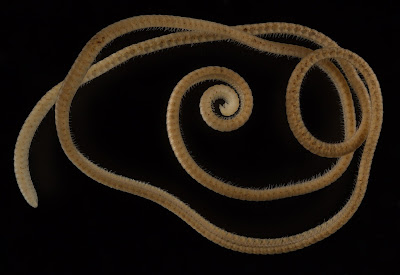 |
| Eumillipes persephone Marek, in Marek, Buzatto, Shear, ... et Rodriguez, 2021. |
Abstract
The name “millipede” translates to a thousand feet (from mille “thousand” and pes “foot”). However, no millipede has ever been described with more than 750 legs. We discovered a new record-setting species of millipede with 1,306 legs, Eumillipes persephone, from Western Australia. This diminutive animal (0.95 mm wide, 95.7 mm long) has 330 segments, a cone-shaped head with enormous antennae, and a beak for feeding. A distant relative of the previous record holder, Illacme plenipes from California, it belongs to a different order, the Polyzoniida. Discovered 60 m below ground in a drill hole created for mineral exploration, E. persephone possesses troglomorphic features; it lacks eyes and pigmentation, and it has a greatly elongated body—features that stand in stark contrast to its closest surface-dwelling relatives in Australia and all other members of its order. Using phylogenomics, we found that super-elongation (> 180 segments) evolved repeatedly in the millipede class Diplopoda. The striking morphological similarity between E. persephone and I. plenipes is a result of convergent evolution, probably for locomotion in similar soil habitats. Discovered in the resource-rich Goldfields-Esperance region and threatened by encroaching surface mining, documentation of this species and conservation of its habitat are of critical importance.
Taxonomy
Class Diplopoda de Blainville in Gervais, 1844
Subterclass Colobognatha Brandt, 1834
Order Polyzoniida Cook, 1895
Family Siphonotidae Cook, 1895
Tribe Rhinotini Hoffman, 1977
Eumillipes, Marek new genus
Type species: Eumillipes persephone Marek, new species.
Generic placement and diagnosis:
The genus Eumillipes is placed in the order Polyzoniida, family Siphonotidae, tribe Rhinotini based on the following characters10,20; whether the character is diagnostic for the order (O), family (F), or tribe (T) is denoted in parentheses. Head capsule small, conical, elongated into a sharp snout (O) (Fig. 1C, Supplementary Fig. S1A–C). Prozonites and metazonites of trunk rings the same width (O) (Supplementary Fig. S2A); prozonites not narrow as in the Siphonophorida. Rings smooth (Supplementary Fig. S2B), covered with neither cuticular ornaments nor long setae as in the Siphonophorida. Vertex of head with two macrosetae (O) (Supplementary Fig. S1C). Antennae thick with equally sized antennomeres (O) (Fig. 1C, Supplementary Fig. S3A); antennae not strongly elbowed between antennomeres 3, 4 as in the Siphonorhinidae (Siphonophorida). Gnathochilarium reduced to three sclerites: mentum; left, right stipes (O). Ozopores located far in from lateral edges of tergites; placed two-thirds the distance from midline laterally to tergal margins (F) (Supplementary Fig. S2D). Vasa deferentia open through small conical lobes (penes) on the posterior surfaces of the second leg coxae (F). Telson a complete ring around the anal valves (F) (Supplementary Fig. S2D). Tarsal claw with long sigmoid-shaped accessory claw at its base that exceeds the claw in length (F) (Supplementary Fig. S1D). The genus differs from other siphonotid genera by the following characters. Anterior gonopods (i.e., 9th leg pair) strongly modified with podomeres 3–4 fused, not leg-like as in Siphonotini genera (T) (Fig. 1C, Supplementary figs. S4, S5A). Apex of anterior gonopods distinctly bifurcated into two processes (Fig. 1C, Supplementary figs. S4, S5A), not a single process as in the genera Rhinotus Cook, 1896 and Siphonoconus Attems, 1930.
Eumillipes persephone Marek, new species
Diagnosis: Adults of Eumillipes persephone can be differentiated from other polyzoniidan genera and species (and commonly encountered millipedes co-occurring with E. persephone in Western Australia) based on the combination of the following characters. Body extremely long and thread-like (width: ♂ 0.92 mm; ♀ 0.95 mm; length: ♂ 54.7 mm; ♀ 95.7 mm). Exoskeleton uniformly pale, cream-colored (Fig. 1A, Supplementary figs. S6–S8)—with neither dark pigmentation nor longitudinal, nor transverse stripes as in surface-dwelling species (Supplementary Fig. S9). Adult millipedes with an exceptional number of rings and legs: ♀ up to 330 rings and 1,306 legs, and ♂ up to 208 rings and 818 legs (Supplementary tab. S1). Head cone-shaped and eyeless (Fig. 1C, Supplementary Fig. S1A–C)—lacking eyes as are present in surface-dwelling species. Ninth and 10th leg pairs modified into gonopods (Fig. 1C, Supplementary figs. S4, S5). Anterior gonopods (9th leg pair) highly modified, not leg like, and distinctly bifurcated into two processes (Fig. 1C, Supplementary figs. S4, S5A). Medial process of the anterior gonopods saddle-shaped—not pointed and recurved as in Siphonotus flavomarginatus Attems, 191121. Lateral process sheath-like and cupping the medial process. Posterior gonopods (10th leg pair) stylet-like, and in repose threaded through the bifurcated anterior gonopods (Fig. 1C, Supplementary figs. S4, S5B). Sterna of gonopods with four long, slender, curved setae apically studded with spinules (Supplementary figs. S4B, S5A).
Etymology: The genus is named because it is the first true millipede with more than 1000 legs. The name Eumillipes is a combination of the Greek eu-, meaning ‘true’; Latin mille, ‘thousand’; and Latin pes, ‘foot’. It is to be treated as a noun. The species epithet is derived from the Greek mythological goddess of the underworld, Persephone, who was originally from the surface but was taken to the underworld by Hades.
Paul E. Marek, Bruno A. Buzatto, William A. Shear, Jackson C. Means, Dennis G. Black, Mark S. Harvey and Juanita Rodriguez. 2021. The First True Millipede—1306 legs long. Scientific Reports. 11: 23126. DOI: 10.1038/s41598-021-02447-0






